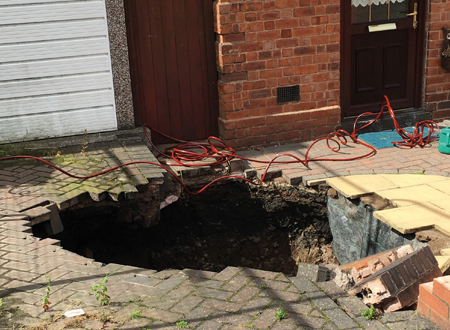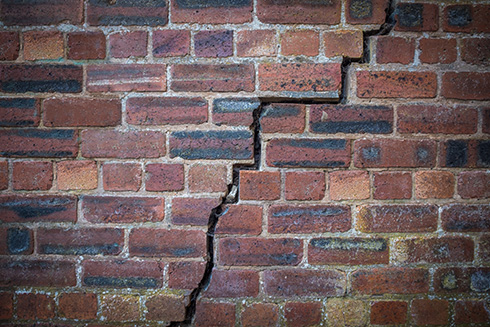Bank Holiday opening hours on Monday 6th May are 9 am – 1pm
What do you do if you have your sights set on a lovely property, only to find that the house you want to buy is near a mineshaft?
You’ll probably be concerned at first – will this stop you from being able to get a mortgage on the property? Not necessarily. In fact, many lenders will consider lending on a property near a mineshaft. Whether they accept this property as security in particular will ultimately come down to the valuer’s comments.
In this guide, we'll look at what exactly it means to buy a home near a mineshaft, as well as the implications of applying for a mortgage for a property like this.
The Topics Covered in this Article Are Listed Below:
- What Is a Mineshaft?
- Where Am I Likely to Find Mineshafts?
- Are There Advantages to Buying Houses Near Mineshafts?
- Can I Get a Mortgage if My House Is Close to a Mineshaft?
- What to Do if the Property Doesn't Meet Standard Criteria
- Is It Harder to Sell a House Near a Mineshaft?
- Who Pays if a Mineshaft Collapses Near My Home?
- Buying a House Close to a Mineshaft - The Bottom Line
What Is a Mineshaft?

A mineshaft is where the ground has been excavated for mining. Typically, mineshafts go down into the earth before spreading out underground, but some can go down at an angle. Mineshafts can be enormous; some are hundreds of feet long and over 15 feet wide. Mineshafts are typically used to excavate coal; metals such as tin, copper and lead; as well as certain types of stone and clay. The excavation and digging typically cause structural risks for the surrounding ground, which is why mineshafts are shored up with beams and struts while they’re excavated.
Most known mineshafts in the UK are no longer in use. By 2020, the UK Coal Authority had recorded 150,000 coal mine shafts and mine entrances that had been closed and sealed up. However, they also estimate that this could be under half of the total number of coal mineshafts in the UK, as many mining sites were not properly recorded. The highest estimates suggest that there are 400,000 unrecorded mine entrances that have been abandoned in the UK. This includes coal, metal and clay mines.
What Are the Risks with Mineshafts?
The main risk of having properties near mineshafts is that there could be subsidence. The damage caused by subsidence can range from being relatively mild, to a whole mineshaft collapse. Full mineshaft collapses can ruin roads, buildings and the natural surrounding landscape. Collapses often open holes in the ground that span anywhere from a metre across to 3 or 4 metres wide. The holes can also be up to hundreds of metres deep. This is a huge risk to consider when buying a property close to a mineshaft. A collapse could structurally weaken the property and could potentially cause it to collapse as well.
When Will These Risks Become a Problem?
Full mineshaft collapses are relatively rare. On average, there are only 15 mineshaft collapses in the UK each year. There are other subsidence issues and structural problems that happen more often than this.
It’s hard to say exactly when a mineshaft could collapse. Most known mineshafts have been repaired and sealed up or filled to help ensure that they’re less likely to cause damage or injury. Property damage is generally considered rarely a result of mineshaft collapse.
Where Am I Likely to Find Mineshafts?
There are many abandoned mineshafts all over the UK, but there are some regions where they’re more common. Old mining sites are most prevalent in South Wales, in areas of England such as Lancashire and Northumberland, and in central Scotland. Cities with a strong history of mining include Cardiff, Swansea, Birmingham, Stoke-On-Trent, Manchester, Sheffield, Newcastle upon Tyne, Glasgow and Edinburgh. These are all well-known industrialised areas, which could mean that there are historical mineshafts nearby.
Are There Advantages to Buying Houses Near Mineshafts?
Properties near mineshafts do have the advantage of often being cheaper than comparable properties. The price decrease from living near a mineshaft can be up to 10% or even 20% compared to nearby properties of a similar size and condition. However, this price difference should be weighed up against the risk of an issue occurring. If the mineshaft is underneath the foundations of the house, which is possible in some rare cases, then the price difference might not be worth it. On the other hand, if the mineshaft is far enough from the building, it could be seen as safer. The exact location of the mineshaft will make a large difference in how easy it is for you to get a mortgage on the property. You can look at our house buying guide for more information on what else to look out for when considering a property.

Can I Get a Mortgage if My House Is Close to a Mineshaft?
Whether or not you can easily get a mortgage near a mineshaft will depend on the exact situation and the valuer’s comments when the lender arranges a valuation for lending purposes. There are plenty of properties near mineshafts that won’t impact your ability to get a competitive mortgage from a high street lender.
The deciding factor will be the risk to the property as deemed by the valuer and the potential loss in value. This is because the property will be used as the security for your mortgage loan. If the property loses a significant amount of its value due to subsidence, mortgage lenders are at risk of not getting their money back if they have to repossess the house.
It’s also highly important how close the building is to the mineshaft. Some shafts might be far enough away that the property itself is at no major risk. Generally, a mineshaft being more than 20 metres away will limit the risk of subsidence significantly.
What Additional Checks Could the Mortgage Lender Need?
There are several ways that mortgage lenders can judge whether or not a property is a safe investment. You might have to seek out these checks and surveys in order to show a mortgage lender that a property is suitable for their criteria:
Valuation for lending purposes: this will discuss the marketability and the risks to the structural integrity of the property. A mortgage lender will arrange a mortgage valuation to gauge how easily a property could be sold if they have to recover their losses in the future.
Environmental survey: an environmental report will show any features nearby, such as mineshafts. This can be useful for houses in areas where there is a high chance of unrecorded mineshafts, as not all mineshafts are reported. It's possible for a seller to not even know that their home is near a mine.
Mining report: you can request a mining report from the UK Coal Authority. This will show the location of all known coal mines in your chosen area. Remember, this will only show coal mines that have been properly recorded.
Structural survey: a full structural survey will show if the building is suffering from subsidence or any other problems. Minor subsidence can show years before a major mineshaft collapse. If you’re buying a property near a mineshaft that already shows subsidence issues, you might struggle to get a mortgage as this could show an imminent risk of further problems.
As long as the lender is content with the results from any valuation, surveys or reports carried out – and you meet the lender’s criteria - then they’ll consider your application and offer your standard rates. If there are issues or you don’t meet the lender’s criteria, then you may require a specialist lender and specialist insurance on the property
What Are the Criteria for Mortgages Near Mineshafts?
The criteria for getting a mortgage on a property near a mineshaft will be the same as for other types of houses, assuming there are no major issues and you don’t require a specialist lender.
This includes:
- Deposit requirements
- Income
- Credit history
- Affordability
If you need a specialist mortgage there will be different criteria. This could include higher income requirements and changes to the deposit amount.
How Much Deposit Will I Need?
If your property is low risk, then you could have access to products with a standard deposit amount. This is usually around 10% as a minimum, though some lenders offer mortgages with a 5% deposit.
Specialist mortgage lenders often require a higher deposit. In this case, you’ll usually find that the minimum deposit value is around 20%.
Can a First-Time Buyer Get a Mortgage for Properties Near a Mineshaft?
Whether you’re a first-time buyer or home mover will have no bearing on your ability to get a mortgage on a property near a mineshaft.
What About Insurance?
Having suitable buildings insurance is part of the criteria for getting a mortgage. This should be easy if your property is not at any great risk. This is more complicated if your property is at a higher risk of damage. You might have to find a specialist insurer to take on this kind of property due to its location, which means you’ll also require a specialist lender. If the house is already showing signs of subsidence then the risk might be too high for insurers to take on. You should consider looking into insurance before starting your application process, as failing to properly protect your home with insurance would stop you from getting a mortgage.
What to Do if the Property Doesn't Meet Standard Criteria
If you want to buy a house close to a mineshaft and find that the risks are too high for a standard mortgage, this does not mean there are no options left. You’d instead need to find a specialist mortgage lender via a specialist mortgage broker like John Charcol.
Not only do we have experience in finding specialist mortgages, but most specialist lenders only work with intermediaries. This means that we have access to more rates and better deals than you would have on your own. We’re also familiar with the different criteria of different specialist mortgage lenders, so we’ll be able to guide you towards a lender that’s suitable for your situation.
Will There Be Additional Costs?
A specialist mortgage will usually come with a bigger minimum deposit requirement and a higher interest rate than most standard products. You may also require specialist insurance which will be more expensive than standard buildings insurance.
Is It Harder to Sell a House Near a Mineshaft?
Yes, it can be harder to sell a property that is near a mineshaft.
This is due to several factors:

- Difficulty acquiring a mortgage: if your property has risk factors that make it hard to get a mortgage, the number of people who will be able to buy the home from you will be limited. Mortgage providers are not keen to offer mortgages for properties that could be hard to sell or at risk of damage. This is why lenders use comments from a valuer when considering whether to lend on a property
- Damage: if the house suffers any damage from subsidence it could become less appealing to buyers. This can be the case even if you have since had the damage repaired, as some people will be concerned about further damage and whether there’s a chance that the mineshaft could collapse again
- Stigma: a lot of people will avoid properties like these due to concerns over damage, even if all the surveys and checks show that the property is not at risk
Who Pays if a Mineshaft Collapses Near My Home?
Mineshaft collapses are expensive to fix. The Coal Mining Subsidence Act 1991 introduced rights for people who suffer damages to their properties due to subsidence from coal mines. Generally, you should be able to get compensation from the Coal Authority. If your home is so badly damaged that it has to be demolished, you might be eligible for compensation for the home's value.
Note that the Coal Mining Subsidence Act only applies to coal mines. Other types of mines will not be covered. If you have property damage caused by another type of mine, you might still be able to make a claim against the mine owner. The claim isn’t guaranteed, and you might have to cover the costs of any necessary repairs yourself or through insurance.
This can have a difference in how easily you can get a mortgage. If the damage is likely to be covered by the Coal Authority, a mortgage lender may be more willing to accept the property as security for the mortgage. This means that houses near other types of mines might be harder to get a mortgage for.
Buying a House Close to a Mineshaft - The Bottom Line
There are hundreds of thousands of old mineshafts in the UK, especially around some of the major industrial regions of the country. These properties can be appealing due to their reduced price, but you should always make sure that you do full research before you start the process to buy a house close to a mineshaft. Surveys and checks will show whether the property is at risk of subsidence issues.
Mineshafts and mortgages are not an immediate no-go. A lot of mortgage lenders will offer standard mortgages on properties as long as the surveys and valuations show that there is no significant risk. However, if there are risks to the property you’re considering, you might have to get a specialist mortgage.
Getting a specialist mortgage could be difficult and you’ll often find that you have to meet stricter criteria and put forward a bigger deposit - the deposit on a specialist mortgage could be double that on a standard offer. Going through a mortgage broker can help make sure that you find mortgage offers for specialist properties, as well as access to the best deals for your circumstances.
Here at John Charcol, we have experience arranging specialist mortgages and we can help find specialist lenders for homes near mineshafts. Get in touch today to see how we can help you secure the right mortgage for your needs.
First-Time Buyer Mortgages
If you’re thinking of buying your first home, discover the latest advice and the best first-time buyer mortgage rates available on the market with John Charcol today.
Applying for a Mortgage
Applying for a mortgage couldn’t be simpler with our easy and simple guide from application to accepting your offer.
How Much Can I Borrow?
This mortgage calculator examines your income and works out how much money a mortgage lender might provide you with
House Buying Mortgage Guide
Are you looking to buy your first home? Or perhaps want to move to a new area? Our step-by-step guide will tell you everything you need to know about buying a house.
Help to Buy Guide
Support from the government-backed Help to Buy initiative is available for first-time buyers and existing homeowners who are finding it difficult to move up the housing ladder.
House Mortgage Deposit
Saving a mortgage deposit for a house is definitely one of the biggest hurdles you face as a buyer. In our guide we explain how deposits work and ways you can save.
Mortgage Deposit Amounts
Learn all about the different mortgage deposit amount options, how they affect your mortgage, how they vary depending on what type of borrower you are & more.
Funding Home Improvements
There are a few ways to finance work on a house: get a home improvement loan, remortgage for home improvements, ask your lender for a further advance & more
Mortgage Glossary
On this page you’ll find our detailed mortgage terminology glossary. There’s a lot of jargon out there but we’re here to make it easy.
